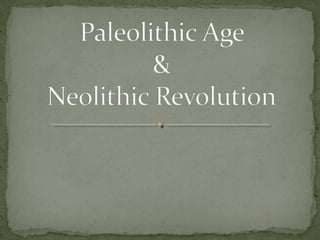
Paleolithic Era vs Neolithic Revolution
- 2. prehistory Hominids (Key Finds) The time before writing. Historians rely on the work of archaeologist and anthropologist to discover the past. Early human ancestors 1. Mary and Louis Leaky Found bones of hominids in East Africa in 1960 2. Donald Johansen Found “Lucy”. Test showed she lived more than 3 million years ago and walked of two legs. 3. Tim White Found even older remains from as long as 4.4 million years ago.
- 4. First Appearance Groups of hominids appeared about 3 million years ago. (Johansen) A group of hominids called Homo erectus, or upright man, appeared in Africa about 1.5 million years ago. Many scientists think that modern humans appeared about 200,000 years ago in Africa.
- 5. The way humans change their environment Example: Before – natural desert landscape with pockets of farming. After – roads, houses, and retail stores are built.
- 7. Stone Tools
- 9. Nomads Societies Hunter- Gatherers Discovery of Fire A person who has no settled home (dwelling). Traveled in groups of 20-30. Keep moving to new places to find food. A community of people who share a common culture Nomads hunted and gathered food for the group. Men = hunters & Women = gatherers Hunted animals & gathered wild plants Discovered during the Old Stone Age. How could this new technology changed the lives of nomads during the Paleolithic Era? Allowed Effects food to of be the cooked Discovery for the of 1st Fire time. Nomads could move to colder climates.
- 10. Nomad Migration Migrated from Africa approx. 1 million years ago. Built temporary dwellings of branches and animals skins. Built near a water source. Why? Once the nomadic group gathered all the food in the area they moved on…
- 12. Summary: Summarize how early humans lived during the Paleolithic Era.
- 13. Create a Thinking Map that illustrates elements of the Paleolithic Era. What style of Thinking Map will you create?
- 14. Paleolithic Era
- 15. Paleolithic Era No settled home 20-30 Nomad
- 16. Revolution Essential Question What is a revolution? Is it positive or negative? Does it always involve war or violence?
- 17. Neolithic Greek for “new stone” (neo = new & lithic = stone) Known as the “New Stone Age”
- 18. Mesopotamia Fertile Crescent About 11,000 years ago FARMING was discovered. Discovered in Asia Fertile Crescent (modern day Middle East) Started the Neolithic Revolution.
- 19. Development of Farming EFFECT = early humans no longer had to be nomads. They could now settle in one place. Still depended on STONE TOOLS. Used the seeds from BIGGEST and best tasting plants to plant crops, which led to…
- 20. Domestication To adapt wild plants for human use; to tame wild animals for human use. Over time, this careful selection of seeds and roots from each crop led to the kinds of food we eat today.
- 21. Domestication During the New Stone Age / Neolithic Revolution, early humans learned to tame wild animals and breed them for human use. 1st domesticated animal = dog Valuable in hunting Sheep, goats, & pigs. Meat, milk, & wool Over time, herders developed animals that were gentler than their wild ancestors and provided more resources.
- 23. Cave Paintings Hand painted/drawn images inside caves on cave walls. Images were added over & over to the cave walls. Over time, a cave could accumulate hundreds of cave drawings/paintings. Colors used: Brown Yellow Tan Dark Red Coal Black
- 25. Ice Age About 1.6 million years ago, many places around the world began to experience long periods of freezing weather, called the ice ages The ice ages ended about 10,000 years ago. Huge sheets of ice covered much of the earth’s land. Many areas that are now underwater were then dry land. A land bridge, or strip of land connecting two continents, probably connected Asia and North America.
- 26. New Stone Age Early humans learned how to cure and store food for the long winter. Used hand-made traps to catch animals (food). Development of primitive types of boats. EFFECT = catch bigger fish in deeper water.
- 28. New Stone Age Early humans learned how to cure and store food for the long winter. Used hand-made traps to catch animals (food). Development of primitive types of boats. EFFECT = catch bigger fish in deeper water. Made clothing & jewelry. Invention of the 1st primitive bow & arrow.
- 29. CIVILIZATION By 3,500 B.C. small farming communities in the Middle East were developing into the world’s 1st cities, marking the rise of CIVILIZATION.
- 30. Centralized Infrastructure Farming led to the development of larger societies and eventually civilization. It is essential that you remember the patterns of civilization: 1. Growth of Centralized Government 2. Organized Religion 3. Writing 4. Artistic Activity 5. Social Structure 6. Rise of Cities/Infrastructure
- 31. Catal Huyuk Modern Turkey First settled: c. 7000BCE Jericho Modern Israel First settled: c. 7000BCE
- 32. Summary: Describe how early humans lived during the Neolithic Revolution.
- 33. Create a web diagram that illustrates elements of the Neolithic Revolution.
